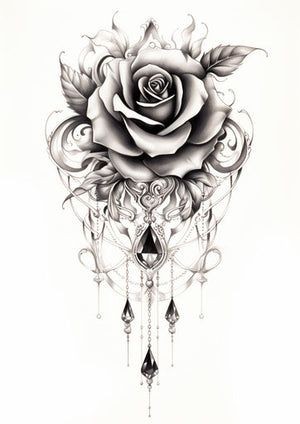The Black Rose Tattoo Design: Symbolism, Popularity, and Artistic Expression
Introduction
Tattoos have long served as a medium for personal expression, cultural identity, and artistic creativity. Among the myriad designs that adorn the human body, the black rose tattoo stands out for its profound symbolism, aesthetic versatility, and historical significance. This article explores the intricate details of the black rose tattoo design, including its origins, symbolic meanings, variations, and its enduring appeal in contemporary tattoo culture.
Origins and Historical Context
The black rose tattoo design has roots that can be traced back to various cultural and historical contexts. The rose, a flower with deep symbolism, has been featured in art, literature, and tattoos for centuries. Traditionally, roses come in a variety of colors, each symbolizing different emotions and concepts. The black rose, however, is relatively unique and less common than its more colorful counterparts.
Historically, the black rose has been associated with Gothic culture and dark romanticism. Its appearance in literature and art often reflects themes of mystery, loss, and transformation. The black rose also has ties to early Christian symbolism, where it was sometimes used to represent the suffering and eventual redemption of Christ.
Symbolism of the Black Rose
The black rose tattoo is rich in symbolism, with meanings that can vary based on personal interpretations and cultural contexts. Here are some of the most common interpretations:
Death and Mourning: The black rose is often linked to themes of death and mourning. It can be a symbol of the end of a significant chapter in one’s life, representing grief or remembrance for a lost loved one.
Rebirth and Transformation: Despite its association with darkness, the black rose can also symbolize rebirth and transformation. The flower’s ability to thrive in seemingly inhospitable conditions mirrors personal growth and resilience.
Mystery and Elegance: The black rose exudes an air of mystery and elegance. It can signify a deep, enigmatic personality or a penchant for exploring the unknown aspects of life.
Defiance and Rebellion: In some contexts, the black rose represents defiance or rebellion against societal norms or personal struggles. It can be a mark of individuality and a statement of one’s unique path.
Romanticism: In Gothic and dark romantic traditions, the black rose can symbolize a complex and passionate love, often associated with themes of tragic or unconventional romance.
Artistic Variations and Styles
The black rose tattoo design can be rendered in various artistic styles, each adding its own unique flair to the tattoo. Some popular styles include:
Traditional: The traditional black rose tattoo features bold lines and simple shading, often with a classic, timeless quality. This style emphasizes clear outlines and a straightforward depiction of the rose.
Realistic: A realistic black rose tattoo aims to capture the intricate details and textures of a real rose. This style often employs shading and color gradients to create a lifelike appearance.
Gothic: Gothic black rose tattoos embrace the dark, mysterious aspects of the rose. These designs often include intricate details, such as thorny stems and shadowy backgrounds, to enhance the Gothic aesthetic.
Watercolor: The watercolor style brings a splash of artistic flair to the black rose design. This technique uses vibrant, flowing colors and brushstroke effects to create a dynamic and visually striking tattoo.
Minimalist: Minimalist black rose tattoos focus on simplicity and subtlety. These designs often feature clean lines and a reduced color palette, highlighting the essence of the rose without excessive detail.
Neo-Traditional: Combining elements of traditional and modern tattoo styles, neo-traditional black rose tattoos feature bold outlines with intricate shading and a slightly more contemporary feel.
Placement and Considerations
The placement of a black rose tattoo can significantly impact its visual impact and personal significance. Common placements include:
Forearm: A popular choice for those who want their tattoo to be visible and easily shown off. The forearm provides a good canvas for detailed designs.
Upper Arm: The upper arm offers more space for larger and more intricate designs. It also allows for the tattoo to be easily covered or displayed as desired.
Back: The back provides a large area for elaborate black rose designs, often incorporating additional elements or themes.
Ribcage: This placement is ideal for those seeking a more private or discreet tattoo. The ribcage allows for expansive and detailed designs, though it can be a more painful area to tattoo.
Leg: The leg, particularly the thigh or calf, offers a sizable area for larger black rose tattoos. This placement can be both striking and versatile.
When considering a black rose tattoo, it's essential to think about the design's size, detail, and placement, as well as the pain tolerance and healing process. Consulting with a skilled tattoo artist can help ensure that the design is executed to perfection and aligns with personal preferences.
The Black Rose Tattoo in Contemporary Culture
In modern tattoo culture, the black rose has gained popularity due to its aesthetic appeal and symbolic depth. It often appeals to individuals who appreciate the juxtaposition of beauty and darkness. The black rose tattoo is favored by those who are drawn to Gothic and alternative subcultures, as well as by people seeking a design that conveys a sense of individuality and personal narrative.
Social media and popular culture have also played a role in the rise of the black rose tattoo. Platforms like Instagram and Pinterest showcase a wide range of black rose designs, inspiring individuals to explore this timeless and versatile tattoo concept.
Conclusion
The black rose tattoo design is a powerful and multifaceted symbol that resonates with many people. Its rich symbolism, artistic flexibility, and historical depth make it a compelling choice for those seeking a tattoo that combines beauty with meaning. Whether chosen for its representation of death, transformation, or mystery, the black rose tattoo continues to captivate and inspire, reflecting the diverse and ever-evolving nature of personal expression through body art.






